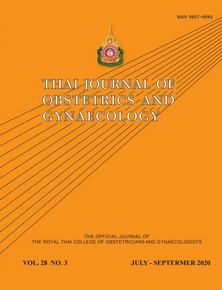Can Video Enhance Confidence in Management of Vaginal Pessary: A randomized trial
Main Article Content
Abstract
Objectives: To compare the confidence of women with pelvic organ prolapse (POP) in vaginal pessary management between those who had versus those who hadn’t watched the teaching video.
Materials and Methods: This randomized clinical trial was conducted at two urogynecological clinics in Khon Kaen, Thailand, from September 2017 to May 2018. Women with POP that require for vaginal pessary were included and were randomized into two groups: 1) treatment group received brochure and watched teaching video, and 2) control group received only educational brochure. Each participant’s knowledge was tested before and after receiving construction from a trained nurse. A retest, which examined participants’ knowledge retention, self-confidence, and satisfaction in pessary use, was conducted at a two-week follow-up visit.
Results: A total of 50 subjects were enrolled: 25 in each video and non-video group. There was no statistically significant difference in median confidence scores between video (median; range = 10; 7-10) and non-video (median; range = 10; 5-10) groups, p = 0.917. There was statistically significant difference in mean pretest and posttest scores in both video and non-video group (3.72 [95%CI 2.98-4.46], p < 0.001 and 3.84 [95%CI 3.10-4.58], p < 0.001, respectively) but no significant difference between two groups (0.12 [-0.60-0.84], p > 0.999). However, the median time required to practice using pessary was significantly shorter in the video group (10 minutes [5, 30] and 15 minutes [7, 20], p = 0.001).
Conclusion: Additional teaching video didn’t affect confidence in vaginal pessary management. However, this tool enhanced patients’ learning.
Article Details
References
Haylen BT, de Ridder D, Freeman RM, Swift SE, Berghmans B, Lee J, et al. An International Urogynecological Association (IUGA)/International Continence Society (ICS) joint report on the terminology for female pelvic floor dysfunction. Neurourol Urodyn 2010;29:4-20.
Fritel X, Varnoux N, Zins M, Breart G, Ringa V. Symptomatic pelvic organ prolapse at midlife, quality of life, and risk factors. Obstet Gynecol 2009;113:609-16.
Samuelsson EC, Victor FT, Tibblin G, Svardsudd KF. Signs of genital prolapse in a Swedish population of women 20 to 59 years of age and possible related factors. Am J Obstet Gynecol 1999;180(2 Pt 1):299-305.
Chuenchompoonut V, Bunyavejchevin S, Wisawasukmongchol W, Taechakraichana N. Prevalence of genital prolapse in Thai menopausal women (using new standardization classification). J Med Assoc Thai 2005;88:1-4.
Committee on Practice Bulletins-Gynecology AUS. Practice Bulletin No. 185: Pelvic organ prolapse. Obstet Gynecol 2017;130:e234-e50.
Cheung RY, Lee JH, Lee LL, Chung TK, Chan SS. Vaginal pessary in women with symptomatic pelvic organ prolapse: a randomized controlled trial. Obstet Gynecol 2016;128:73-80.
Brown LK, Fenner DE, DeLancey JO, Schimpf MO. Defining patient knowledge and perceptions of vaginal pessaries for prolapse and incontinence. Female Pelvic Med Reconstr Surg 2016;22:93-7.
Murray C, Thomas E, Pollock W. Vaginal pessaries: can an educational brochure help patients to better understand their care? J Clin Nurs 2017;26:140-7.
Kearney R, Brown C. Self-management of vaginal pessaries for pelvic organ prolapse. BMJ Qual Improv Rep 2014;3:u206180.w2533.
Cundiff GW, Weidner AC,Visco AG, Bump RC, Addison WA. A survey of pessary use by member of the American Urogynaecological Society. Obstet Gynecol 2000;95:931-5.
Palumbo MV. Pessary placement and management. Ostomy/wound management 2000;46:40-5.
Coulter A, Ellins J. Effectiveness of strategies for informing, educating, and involving patients. BMJ 2007;335:24-7.
McCarthy DM, Waite KR, Curtis LM, Engel KG, Baker DW, Wolf MS. What did the doctor say? Health literacy and recall of medical instructions. Med Care 2012;50: 277-82.
Hooper GL. Person-Centered Care for Patients with Pessaries.Nurs Clin North Am 2018;53:289-301.
O’Dell K, Atnip S, Hooper G, Leung K. Pessary practices of nurse-providers in the United States.Female Pelvic Med Reconstr Surg 2016;22:261-6.
Richardson K, Hagen S. The role of nurses in the management of women with pelvic organ prolapse. Br J Nurs 2009;18:294-296,298-300.
Yimphong T, Temtanakitpaisan T, Buppasiri P, Chongsomchai C, Kanchaiyaphum S. Discontinuation rate and adverse events after 1 year of vaginal pessary use in women with pelvic organ prolapse. Int Urogynecol J 2018;29:1123-8.
Duenas JL, Miceli A. Effectiveness of a continuous-use ring-shaped vaginal pessary without support for advanced pelvic organ prolapse in postmenopausal women. Int Urogynecol J 2018; 26:1629-36.
Robert M, Schulz JA, Harvey MA. Technical update on pessary use. JOGC 2013;35: 664-74.
de Albuquerque Coelho SC, de Castro EB, Juliato CR. Female pelvic organ prolapse using pessaries: systematic review. Int Urogynecol J 2016;27:1797-803.

